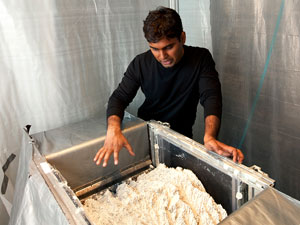
University of Minnesota to lead international virtual institute for study of climatic and human effects on Earth
December 12, 2012
The National Science Foundation (NSF) announced that it will award an $720,000 grant to the University of Minnesota to lead an international, multi-university virtual institute for the study of Earth-surface systems, with a special emphasis on watersheds and deltas.
Linked Institutions for Future Earth (LIFE) is a new collaborative network of leading international research institutions, facilities and field sites working together on research related to predicting and understanding the impacts of climatic and human stresses on the landscape. LIFE seeks to produce research that informs policymakers and practitioners, while cultivating effective researcher exchange and mentoring, and generating innovative international public engagement toward landscape sustainability.
The project is funded through NSF’s Science Across Virtual Institutes (SAVI), a mechanism to advance scientific understanding and excellence through the collaboration of scientists, engineers and educators across continents, cultures and disciplines.
Faculty members from the St. Anthony Falls Laboratory (SAFL) in the University of Minnesota’s College of Science and Engineering, including Efi Foufoula-Georgiou (civil engineering), Chris Paola (earth sciences) and Vaughan Voller (civil engineering), will serve as the lead researchers of the project. Foufoula-Georgiou is also a resident fellow of the university's Institute on the Environment.
"Building upon the 10-year success of the NSF-funded National Center for Earth-surface Dynamics (NCED), this new virtual institute represents a significant step toward a broader understanding of the natural and human-induced changes that impact watersheds and deltas around the world," said LIFE lead researcher Efi Foufoula-Georgiou. "LIFE seeks to empower the next generation of Earth-system scientists, engineers and educators with depth, breadth and a global perspective on environmental sustainability."
Led by the University of Minnesota, the LIFE virtual institute will extend the collaborative research and training expertise of NCED, while utilizing the unique experimental facilities at the St. Anthony Falls Laboratory. In addition, the pilot implementation of LIFE includes the following participating institutions from across the globe:
- University of California, Berkeley
- University of Texas, Austin
- University of Illinois, Urbana-Champaign
- Science Museum of Minnesota
- University of Aberdeen, United Kingdom
- University of Exeter, United Kingdom
- Institute de Physique du Globe de Paris, France
- CIMA Research Foundation, Italy
- Universidad de la Republica, Uruguay
- Pontificia Universidad Católica de Chile, Chile
The LIFE network leverages funding and resources totaling more than $30 million, through existing grants and investments in the participating institutions.
LIFE will concentrate its efforts on two critical regions in the Earth-surface environment—watersheds and deltas. Utilizing the network’s shared experimental facilities, broad strengths in theoretical, experimental and field analysis, and extensive data sets, collaborative programs through LIFE will contribute toward a broader understanding of the vulnerability of watersheds and deltas to natural and human-induced changes including hazards.
LIFE’s seven major programs are:
- researcher exchange;
- shared and co-mentored post-doctoral researchers;
- international shared graduate degree programs;
- theme-based focused research (experimental and theoretical) campaigns;
- international summer institutes for graduate students and young researchers;
- data/model sharing for actionable research, and
- science to public international exchange.
"The unique elements of the LIFE education programs provide the opportunity for emerging researchers to develop a global perspective on challenges and solutions to key environmental concerns," said LIFE education coordinator Vaughan Voller.
For additional information, visit the LIFE website at www.life.umn.edu or visit the NSF SAVI website at http://www.nsf.gov/news/special_reports/savi/.

